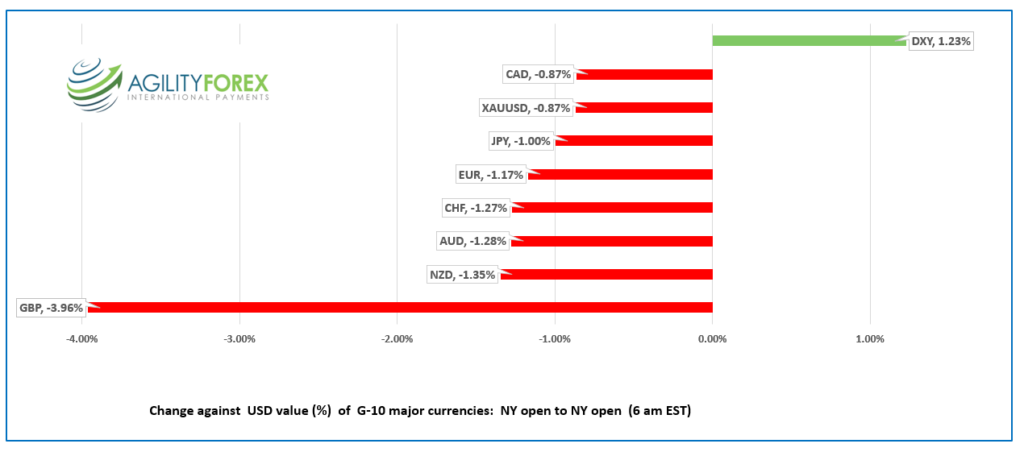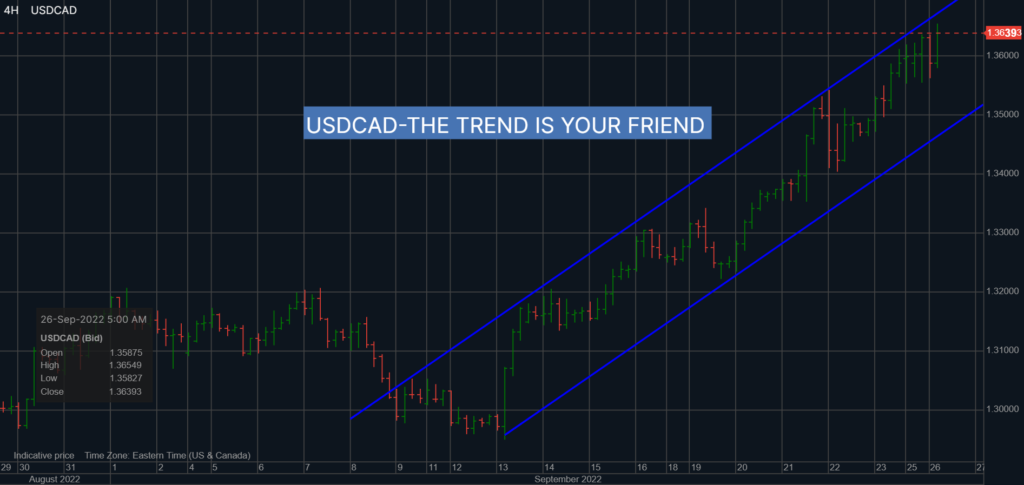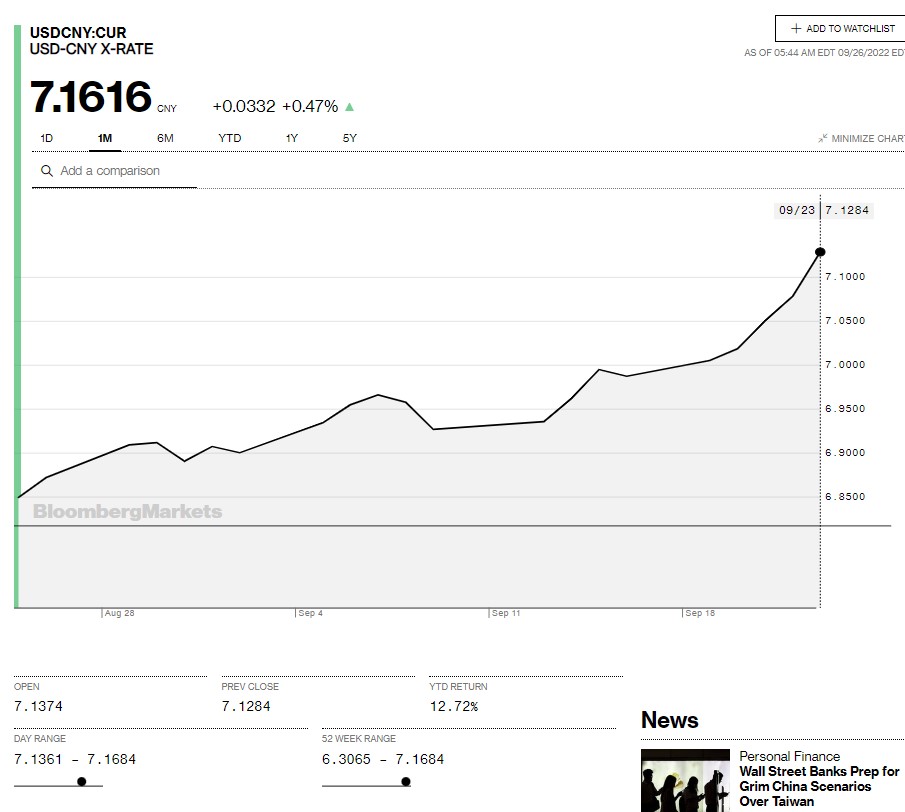
Source: Freepik.com
- “Flash-Crash knocks GBPUSD to lowest level ever, before returning to Friday close
- Hawkish Fed-speak from Bostic, Right-wingers ruling Italy
- US dollar extends gains across the board
FX at a glance:

Source: IFXA Ltd/RP
USDCAD Snapshot: open 1.3641-45, overnight range 1.3561-1.3694, close 1.3590
USDCAD traded erratically, albeit with a bullish bias in a 1.3561-1.3635 range until just before NY opened when prices climbed to 1.3655. The peak coincided with S&P 500 futures probing overnight session lows in the 3660 area.
USDCAD is also suffering from the drop in WTI oil prices. WTI fell below the September uptrend line at $80.40/barrel Friday and continued down to $77.25 before climbing to $77.96 in NY. The technical picture is negative below $87.90/b with the break below $80.00/b reverting to resistance.
USDCAD price action is closely tracking S&P 500 moves and the lack of US and Canadian data will ensure the trend continues today.
USDCAD Technical outlook
The intraday USDCAD are bullish above 1.3580 looking for a break above 1.3690 to extend gains to 1.3750. A break below 1.3580 targets 1.3490. Longer term, the USDCAD uptrend channel (4-hour chart) from September 13, shows uptrend support at 1.3480 and resistance at 1.3680
For today, USDCAD support is at 1.3570 and 1.3510. Resistance is at 1.3670 and 1.3710. Today’s range: 1.3590-1.3690
Chart: USDCAD 4 hour

Source: Saxo Bank
G-10 FX recap and outlook
The greenback is racing ahead and running over everything in its path. The new week started with a GBPUSD “flash-crash in Asia causing collateral damage across the G-10 currency spectrum, more saber-rattling from Russia, Chinese blustering about Taiwan, and hawkish talk from Atlanta Fed President Raphael Bostic.
The Organization for Economic Cooperation and Development (OECD) piled on the bad news reporting that Russia’s invasion of Ukraine will cost the global economy $2.8 trillion in lost output by the end of 2023. They also downgraded their 2023 global GDP growth forecast to 2.2% from 3.0%.
Italy has shifted to the right. Giorgia Meloni, leader of the Brother of Italy party, will become Prime Minister and lead a coalition of two-other right-wing groups that are somewhat Euro-skeptic.
Russia plans to formally recognize the weekend referendums in Ukraine territory, ceding the territory to Russia on Friday, which then means Moscow could use nuclear weapons to defend its new lands. The US warned of “catastrophic consequences” for such a move.
FOMC voting member Raphael Bostic said that inflation was too high and that the Fed needed to do all it could to bring it down to its 2.0% target. Nothing new, but his words kept the spotlight on the US interest rate outlook.
EURUSD traded in a 0.9554-0.9709 range, with the bottom hit during the GBPUSD sell-off. Prices rallied sharply off the low, reaching 0.9698 before dropping back to 0.9652 in NY. The war in Ukraine, the risk of an EU clash with Italy, the European energy crisis, and the risk of higher US interest rates are weighing on prices. In addition, weaker than expected, German IFO data suggest a recession has arrived. The EURUSD technicals are bearish below 0.9800.
GBPUSD is a mess. Market flash-crashes most often occur in Asia when liquidity for most financial instruments is poor, and this time, the British pound was the victim. GBPUSD plunged from 1.0844 to 1.0355 in early Asia trading, a level last seen in 1971. Prices rebounded, but it took nearly eight hours before it recovered all its losses.
GBPUSD sentiment is bearish, with the currency being punished by what is viewed as a very tepid Bank of England response to government stimulus spending and the higher interest rate outlook globally. Some analysts have speculated about an intra-meeting emergency BoE rate hike to provide some support to the currency. That doesn’t sound too likely, as it would mean BoE policymakers would admit they do not know what they are doing.
USDJPY rallied from its Asia low of 143.29, reaching 144.37 in NY. Prices are supported by the US 10-year Treasury yield sitting at 3.779%, although traders are wary of BoJ intervention at current levels. Reuters reported that the BoJ spent yen 3.6 trillion (USD 24.8 billion) intervening last Thursday. BoJ Governor Kuroda defended the intervention noting that the weakening of the yen was “rapid and one-sided.”
He added, “Such depreciation of the yen is negative for the Japanese economy because it makes it difficult for companies to create business plans and raises uncertainty for the future.” He didn’t say anything about the BoJ policy to cap the JGB yield at 0.25%, which caused the USDJPY rally.
AUDUSD traded erratically due to the broad US dollar moves.
There are no top-tier US economic reports today.
FX open, high, low, previous close as of 6:00 am ET

Source: Saxo Bank
China Snapshot
Today’s Bank of China Fix: 7.0298, previous 6.9920
Shanghai Shenzhen CSI 300 fell 0.34% to 3,856.02
USDCNY fix at 28 month low, despite the FIX level being manipulated lower than expected
PboC announced a 20% risk reserve requirement for FX forwards as of September 28
China Foreign Minister Wang Yi told US Secretary of State Blinken that Taiwan is an internal matte. The US has no right in any way to resolve it. He said US is attempting to undermine China sovereignty.
Chart: USDCNY 1 month

Source: Bloomberg





